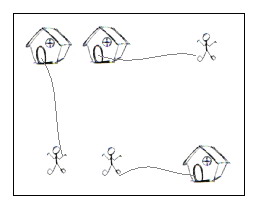题目链接:http://acm.hdu.edu.cn/showproblem.php?pid=1533
我的链接:http://acm.hust.edu.cn:8080/judge/contest/view.action?cid=17728#problem/B
Going Home
Time Limit: 10000/5000 MS (Java/Others) Memory Limit: 65536/32768 K (Java/Others)Total Submission(s): 1895 Accepted Submission(s): 918
Problem Description
On a grid map there are n little men and n houses. In each unit time, every little man can move one unit step, either horizontally, or vertically, to an adjacent point. For each little man, you need to pay a $1 travel fee for every step he moves, until he enters a house. The task is complicated with the restriction that each house can accommodate only one little man.
Your task is to compute the minimum amount of money you need to pay in order to send these n little men into those n different houses. The input is a map of the scenario, a '.' means an empty space, an 'H' represents a house on that point, and am 'm' indicates there is a little man on that point.

You can think of each point on the grid map as a quite large square, so it can hold n little men at the same time; also, it is okay if a little man steps on a grid with a house without entering that house.
Your task is to compute the minimum amount of money you need to pay in order to send these n little men into those n different houses. The input is a map of the scenario, a '.' means an empty space, an 'H' represents a house on that point, and am 'm' indicates there is a little man on that point.

You can think of each point on the grid map as a quite large square, so it can hold n little men at the same time; also, it is okay if a little man steps on a grid with a house without entering that house.
Input
There are one or more test cases in the input. Each case starts with a line giving two integers N and M, where N is the number of rows of the map, and M is the number of columns. The rest of the input will be N lines describing the map. You may assume both N and M are between 2 and 100, inclusive. There will be the same number of 'H's and 'm's on the map; and there will be at most 100 houses. Input will terminate with 0 0 for N and M.
Output
For each test case, output one line with the single integer, which is the minimum amount, in dollars, you need to pay.
Sample Input
2 2 .m H. 5 5 HH..m ..... ..... ..... mm..H 7 8 ...H.... ...H.... ...H.... mmmHmmmm ...H.... ...H.... ...H.... 0 0
Sample Output
2 10 28
Source
Recommend
lwg
w[i][j]=△x+△y 然后因为是求最小值,而KM是求最大值
所以只要这样:w[i][j] = -w[i][j]建图再套模板输出【-sum】就ok!
PS:思路看的网上牛人的,初学KM,代码效率较低。
//Accepted 348 KB 62 ms C++ 2069 B
#include<cstdio>
#include<cstring>
#include<algorithm>
using namespace std;
const int maxn=110;
char map[maxn][maxn];
int w[maxn][maxn];
bool s[maxn],t[maxn];
int match[maxn];
int lx[maxn],ly[maxn];
int n;
bool hungary(int u){
s[u]=true;
for(int v=1;v<=n;v++){
if(!t[v] && lx[u]+ly[v]==w[u][v]){
t[v]=true;//易遗忘
if(match[v]==-1 || hungary(match[v])){
match[v]=u;
return true;
}
}
}
return false;
}
int KM(){
int ans=0;
memset(match,-1,sizeof(match));
for(int i=1;i<=n;i++){
lx[i]=-1<<30;//注意
}
memset(ly,0,sizeof(ly));
for(int i=1;i<=n;i++)
for(int j=1;j<=n;j++)
lx[i]=max(lx[i],w[i][j]);
for(int i=1;i<=n;i++){
while(1){
memset(s,false,sizeof(s));
memset(t,false,sizeof(t));
if(hungary(i)) break;
else{
int a=1<<30;
for(int j=1;j<=n;j++) if(s[j]){
for(int k=1;k<=n;k++) if(!t[k] && a>lx[j]+ly[k]-w[j][k])
a=lx[j]+ly[k]-w[j][k];
}
for(int j=1;j<=n;j++){
if(s[j]) lx[j]-=a;
if(t[j]) ly[j]+=a;
}
}
}
}
for(int i=1;i<=n;i++) ans+=w[match[i]][i];
return -ans;//易遗忘
}
int main(){
int row,col,numi,numj;
while(scanf("%d%d%*c",&row,&col)!=EOF){
if(row==0 || col==0) break;
n=numi=numj=0;
for(int i=1;i<=row;i++){
for(int j=1;j<=col;j++){
scanf("%c",&map[i][j]);
if(map[i][j]=='m') n++;
}
getchar();
}
for(int i=1;i<=row;i++){
for(int j=1;j<=col;j++){
if(map[i][j]=='m'){
numi++;numj=1;
for(int k=1;k<=row;k++){
for(int e=1;e<=col;e++){
if(map[k][e]=='H')
w[numi][numj++]=-(abs(i-k)+abs(j-e));
}
}
}
}
}
printf("%d\n",KM());
}
return 0;
}




























 被折叠的 条评论
为什么被折叠?
被折叠的 条评论
为什么被折叠?








